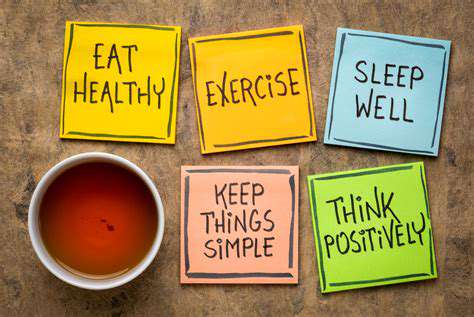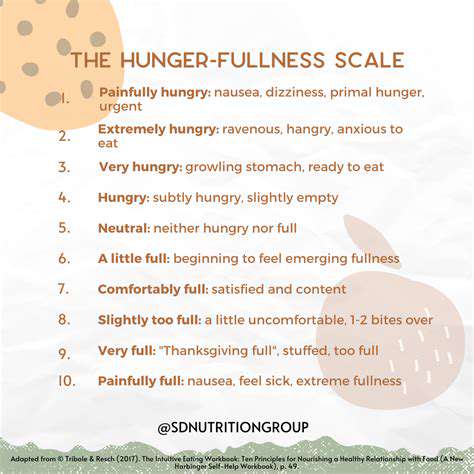
Moving Beyond Metrics: A Holistic Approach
While quantifiable metrics are undeniably important in assessing progress, focusing solely on scales often obscures a deeper understanding of the underlying issues and complexities. A truly effective strategy necessitates moving beyond the immediate data points and delving into the nuanced context surrounding them. This approach requires a shift in mindset, acknowledging that the bigger picture is often more valuable than any single data point.
A holistic perspective considers the interconnectedness of various factors, including individual experiences, environmental influences, and systemic challenges. By understanding these interdependencies, we can develop strategies that are more likely to yield sustainable and meaningful results. This approach is not about abandoning metrics, but rather integrating them into a broader framework that recognizes the multifaceted nature of the issues at hand.
Understanding the Context: Qualitative Insights
To truly understand the impact of a particular initiative, it's essential to gather qualitative data. This involves engaging with stakeholders, conducting interviews, and observing behaviors in real-world settings. These methods provide rich insights into the lived experiences of those affected, offering a deeper understanding of the challenges and opportunities that might not be apparent from purely quantitative data.
This type of contextual understanding is crucial for developing solutions that resonate with the specific needs and circumstances of the individuals and communities being served. Qualitative research allows us to explore the why behind the numbers, offering invaluable insights for impactful strategies.
Developing Actionable Strategies: A Collaborative Approach
Effective strategies for moving beyond the scale are not developed in isolation. Collaboration among diverse stakeholders is essential for creating solutions that are both relevant and sustainable. This collaborative effort should include representatives from various backgrounds, perspectives, and levels of influence, ensuring that a wide range of expertise and experiences are incorporated into the process.
By fostering open dialogue and shared understanding, we can identify common goals and develop actionable steps that address the root causes of the challenges being faced. This collaborative approach ensures that the solutions are not only theoretically sound but also practically feasible and sustainable in the long run.
Prioritizing Impact over Numbers: A Shift in Focus
A critical aspect of moving beyond the scale is prioritizing the impact of interventions over simply achieving numerical targets. Focusing on the qualitative improvements and tangible changes that result from an initiative is often more valuable than simply focusing on the numbers themselves. This shift in focus allows us to measure success in terms of real-world outcomes and tangible benefits for those affected.
By prioritizing the lived experiences and well-being of individuals and communities, we can create strategies that are not only effective but also ethical and just. This means actively considering the potential unintended consequences of our actions and working towards solutions that benefit all stakeholders.
Long-Term Vision: Sustainability and Adaptability
A comprehensive strategy for moving beyond the scale must consider the long-term implications of any intervention. This involves developing strategies that are not only effective in the short term but also sustainable and adaptable in the face of evolving circumstances. A long-term vision necessitates anticipating future challenges and adapting approaches as needed.
This also involves building capacity and resilience within the communities being served. By empowering individuals and groups to take ownership of their own well-being, we can create systems that are self-sustaining and capable of adapting to the ever-changing landscape of the future.
Identifying the signs of arthritis in pets can be challenging, as they often don't exhibit the same symptoms as humans. Many pet owners may initially attribute stiffness or reluctance to move to other factors, like old age or simply a grumpy mood. However, subtle changes in behavior and movement can be early indicators of joint pain. It is crucial to pay attention to these early warning signs to ensure your pet receives timely veterinary care and maintains a good quality of life.
Reconnecting with Your Body's Hunger and Fullness Cues

Understanding the Importance of Body Awareness
Developing a deeper connection with your physical self is crucial for overall well-being. Paying attention to your body's signals, both subtle and overt, can reveal vital information about your physical and emotional state. This awareness allows you to respond to your needs proactively, rather than reactively. Understanding hunger cues, recognizing fatigue, or acknowledging pain are all part of cultivating this essential skill.
By tuning into your body's whispers, you're better equipped to make healthier choices. This awareness translates into improved sleep, enhanced energy levels, and a more mindful approach to daily activities.
Mindfulness and Body Scan Meditation
Mindfulness practices, such as body scan meditation, are powerful tools for cultivating body awareness. These practices encourage you to bring your attention to different parts of your body, noticing sensations without judgment. This non-judgmental observation helps to break down the barriers between your mind and body, fostering a deeper understanding of your physical experience.
Regular practice can help you identify patterns in your physical responses to stress, emotions, and other external factors. This knowledge can empower you to develop coping mechanisms and manage stress more effectively.
The Role of Sensory Experiences
Engaging all your senses can significantly enhance your connection with your body. Pay attention to the textures of different fabrics, the warmth of the sun on your skin, or the taste of fresh food. By actively engaging your senses, you create a rich tapestry of physical experiences that strengthen your relationship with your physical self.
This heightened awareness of sensory details allows you to appreciate the nuances of your physical world and fosters a profound sense of presence in the present moment.
Physical Activity and Movement
Regular physical activity is essential for developing a strong connection with your body. Whether it's a brisk walk, a yoga session, or a dance class, movement allows you to experience your body's capabilities and limitations. This active engagement fosters a sense of strength and resilience, promoting a positive body image.
Nutrition and Hydration
Nourishing your body with wholesome foods and staying hydrated are vital aspects of reconnecting with your body. Pay close attention to how different foods make you feel. Observe how your body responds to different levels of hydration. This mindful approach to nutrition and hydration fosters a deeper understanding of your body's needs and preferences.
This increased awareness will lead to healthier eating habits and a greater appreciation for the vital role food plays in your overall well-being.
Emotional Regulation and Body Awareness
Your body often provides clues about your emotional state. Learning to recognize these cues, such as tension in your shoulders or a racing heart, can help you understand and manage your emotions more effectively. This awareness allows you to respond to emotional triggers with greater clarity and composure.
By understanding the connection between your emotions and physical sensations, you can develop healthier coping mechanisms for stress and anxiety.
Self-Care Practices and Body Connection
Self-care practices are essential for nurturing your body and mind. Activities such as massage, stretching, and deep breathing exercises can help you feel more grounded and connected to your physical self. These practices help you unwind and relax, reducing stress and promoting overall well-being.
Implementing regular self-care routines can create a space for reflection and rejuvenation, ultimately strengthening your connection with your body.
Building a Sustainable Eating Pattern
Understanding Your Current Eating Habits
Taking stock of your current eating habits is crucial to building a sustainable eating pattern. This involves more than just noting what you eat; it's about understanding *why* you eat certain foods, when you eat, and how your eating patterns relate to your overall well-being. Are you driven by emotional triggers, societal pressures, or simply habit? Understanding these underlying factors is the first step towards making conscious and sustainable changes.
Consider keeping a food journal for a week or two. Record not only what you eat but also your emotions, your level of hunger, and the time of day. This detailed record will provide valuable insights into your current eating habits, allowing you to identify patterns and potential areas for improvement. By understanding the 'why' behind your choices, you can begin to create a more mindful and sustainable relationship with food.
Setting Realistic and Achievable Goals
Building a sustainable eating pattern isn't about overnight transformations; it's about making gradual, manageable changes over time. Setting unrealistic goals can lead to frustration and ultimately derail your efforts. Instead, focus on small, achievable steps that you can consistently incorporate into your daily routine. For example, aim to increase your intake of fruits and vegetables by one serving per day, rather than aiming for a complete overhaul of your diet all at once.
Consider your current lifestyle and commitments. Are you working long hours? Do you have young children? Factor in these realities when setting your goals. A sustainable eating pattern is one that can be maintained long-term, not just for a few weeks. By acknowledging your constraints and incorporating gradual changes, you're setting yourself up for lasting success.
Incorporating Nutrient-Rich Foods
A sustainable eating pattern emphasizes the importance of nutrient-rich foods. This means incorporating a variety of fruits, vegetables, whole grains, lean proteins, and healthy fats into your diet. These foods provide essential vitamins, minerals, and fiber that support your body's overall health and well-being. Focus on whole, unprocessed foods rather than relying heavily on processed or packaged items.
Explore different cuisines and cooking methods to discover new and exciting ways to enjoy these nutrient-rich foods. Experiment with recipes, try new fruits and vegetables, and discover the flavors and textures that appeal to you. This exploration will help you create a diverse and satisfying diet that you can sustain over time. Nutrient-rich foods are not just good for your physical health, but also for your mental well-being, as they can contribute to feelings of energy and satisfaction.
Managing Emotional Eating and Maintaining Consistency
Emotional eating is a common challenge when trying to build a sustainable eating pattern. It's important to recognize the connection between your emotions and your food choices. When you're feeling stressed, anxious, or down, do you turn to food for comfort? Identifying these emotional triggers is the first step in managing them. Developing healthy coping mechanisms, such as exercise, mindfulness, or spending time with loved ones, can help you navigate these emotional moments without resorting to food.
Consistency is key to maintaining a sustainable eating pattern. It's not about perfection, but about making mindful choices most of the time. Be kind to yourself if you slip up. Instead of beating yourself up, acknowledge the slip-up, learn from it, and get back on track with your next meal. Remember, building a sustainable eating pattern is a journey, not a destination. By embracing flexibility and consistency, you can cultivate a healthy relationship with food and nourish your body in a sustainable way.